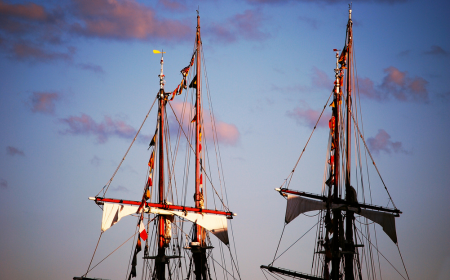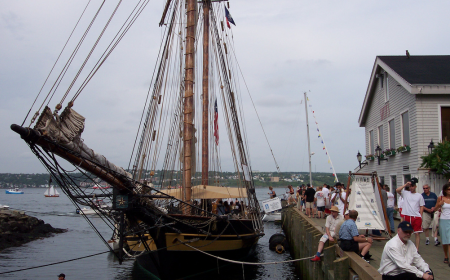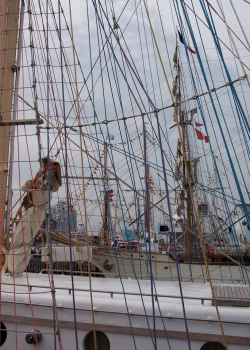During the late 1860s, the hoop skirt gave way to the bustle. Huge skirts advanced into a more slim line with the fabric concentrated and pulled to the back of the dress. The first of these new fashions still had some fullness at the front but the most of it was now centered and pouffed at the back. The 1870s were a transitional period for women and their fashions. Perhaps because of these changes, the era was full of creativity and intriguing ideas; the bustle came back into fashion, albeit much different than it’s predecessor. Trains reappeared and fabric was used in huge quantities, trims too were used to the extreme; a woman could never add too much trim to her gown.
Much of the overindulgence in ladies’ fashions was due to that new fangled invention and the wide spread use of the contraption known as the sewing machine. All those trims, tucks, and pleats that once had to be sewn by hand could now be done by machine. Not too many of us have a very good idea of how slow hand sewing was/is – can you imagine sewing the long and endless seams of the skirts and gowns of that time? We would also likely chuckle at the slowness of middle nineteenth century sewing machines compared with what is available to a seamstress today. I own such a peddle machine, (although I don’t sew on it) it is powered by ones feet, no motors, electricity or computers. I learned to sew on just such a one when I was in my early teens and my mother still has it at home. The early sewing machines sewed over one thousand stitches per minute, and this was at least sixty times faster than hand sewing. The result of this was that what once was very expensive to produce was now much more affordable. What previously only the wealthy could wear, now the middle class could create themselves.
sewing was/is – can you imagine sewing the long and endless seams of the skirts and gowns of that time? We would also likely chuckle at the slowness of middle nineteenth century sewing machines compared with what is available to a seamstress today. I own such a peddle machine, (although I don’t sew on it) it is powered by ones feet, no motors, electricity or computers. I learned to sew on just such a one when I was in my early teens and my mother still has it at home. The early sewing machines sewed over one thousand stitches per minute, and this was at least sixty times faster than hand sewing. The result of this was that what once was very expensive to produce was now much more affordable. What previously only the wealthy could wear, now the middle class could create themselves.
 In addition to the laces and trims that were made at home or in a dressmaker’s shop, many trims could be purchased and were produced en mass. Everything from pleated yardage, to flounces, to tucked materials, to bindings and elaborate cut-work could be bought at the general store. Women rushed to take advantage of these advances and even the simplest house dresses were trimmed, frilled and required large amounts of fabric. It must have been so exciting for them!
In addition to the laces and trims that were made at home or in a dressmaker’s shop, many trims could be purchased and were produced en mass. Everything from pleated yardage, to flounces, to tucked materials, to bindings and elaborate cut-work could be bought at the general store. Women rushed to take advantage of these advances and even the simplest house dresses were trimmed, frilled and required large amounts of fabric. It must have been so exciting for them!
I have always loved the bustle gown. The distinguished lady with her ruffled or pleated, laced and bustled skirts, the feathered hats tilted smartly to the front or the side of the head, the beautiful laces and trims and the rows of buttons embellishing the bodices, which in contrast to the skirts were fitted snugly. They made a woman look beautiful, feminine and curvaceous. Padding was used in the bodices at the bust and under the arms area giving a woman a soft rounded look; and the seams for the sleeves were set in just slightly off the shoulder.
For the first bustle gown I decided to sew, I secured a Truly Victorian pattern for the polonaise. A piece that became very popular in about 1873 and was styled in many different ways. It was actually a combination bodice and over-skirt, saving the woman of wearing these pieces separately. The fitting process for these patterns is done a little differently then the usual way; (Victorian tailoring methods are used), but once you get the hang of it, it’s not really that hard and it does give one a very good fit. The skirt I designed and drafted myself using fashion plates of the period for my inspiration. I left it untrained as I wanted a walking skirt.
 The entire ensemble was sewn using a beautiful green shot taffeta. I trimmed the polonaise with various venise laces – a beautiful four inch floral for around the sleeves and the bottom front, and I edged the entire front with a lovely one inch swagged lace which I also added to the basque back. I found the prettiest gold and black store bought daisy buttons for closures and also pleated black satin ribbon which I added to the bustle at the bottom edge at the back of the polonaise. The skirt was over-layered with a black floral lace to just below where the polonaise ended in the front, and I pleated and added about a 12 inch length of taffeta around the bottom of the skirt; which I trimmed with thick black braided trim. I always add my trims by hand as I find that a sewing machine is just to rough on these beautiful additions, plus I find it a pleasant task to sit in the evening and sew. It also gives my hands something to do as I find it difficult to sit and do nothing.
The entire ensemble was sewn using a beautiful green shot taffeta. I trimmed the polonaise with various venise laces – a beautiful four inch floral for around the sleeves and the bottom front, and I edged the entire front with a lovely one inch swagged lace which I also added to the basque back. I found the prettiest gold and black store bought daisy buttons for closures and also pleated black satin ribbon which I added to the bustle at the bottom edge at the back of the polonaise. The skirt was over-layered with a black floral lace to just below where the polonaise ended in the front, and I pleated and added about a 12 inch length of taffeta around the bottom of the skirt; which I trimmed with thick black braided trim. I always add my trims by hand as I find that a sewing machine is just to rough on these beautiful additions, plus I find it a pleasant task to sit in the evening and sew. It also gives my hands something to do as I find it difficult to sit and do nothing.
 For matching accessories I bought a smart, green, plain wool hat and trimmed it with gathered and somewhat pleated taffeta to the brim, black embroidered lace over the crown, and satin ribbon left both plain and ruched around the crown. The outside of the brim was also decorated with black braid. I finished by making a matching reticule with a bit of the left over taffeta, braid and beaded trim. Such things as matching hats and reticules are a great way of using up leftover trims and fabrics.
For matching accessories I bought a smart, green, plain wool hat and trimmed it with gathered and somewhat pleated taffeta to the brim, black embroidered lace over the crown, and satin ribbon left both plain and ruched around the crown. The outside of the brim was also decorated with black braid. I finished by making a matching reticule with a bit of the left over taffeta, braid and beaded trim. Such things as matching hats and reticules are a great way of using up leftover trims and fabrics.
When we went to Sherbrooke Village I also carried a black parasol, wore black elbow length non-shiny gloves and black shoes. Underneath the dress I wore a small bustle, bloomers and cabled stockings. Because it was a 3.5 hour drive to Sherbrooke and I did not have help to lace it up, I did not wear a corset, although I do own one and the dress does have an even better shape when it is worn with it.
I am very happy with this gown! I feel good in it and it’s really pretty comfortable to wear.





















